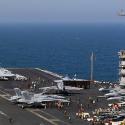 |
 |
U.S. Navy Positions Ships for Possible Strike Against Syrian Targets

U.S. Navy warships are positioned for a strike against Syria using long range Tomahawk Land Attack Missiles (TLAM). Such an attack could cause varying degrees of limited damage to the Assad regime’s ability to use more chemical weapons or continue effective operations against the opposition. It cannot eliminate the regime’s military or chemical weapons capabilities, however, nor cause more than a temporary degradation in regime operations. Such a strike will be ineffective unless it is part of a coherent, properly resourced effort towards achieving clearly-articulated U.S. strategic aims in Syria. Those aims should include helping the moderate and more secular elements of the opposition defeat both the Iranian-backed Assad regime and the al Qaeda-affiliated extremists who threaten to hijack the rebellion. Limited TLAM strikes alone will not accomplish such aims.
The United States seems to be preparing to take direct military action in Syria. The U.S. Navy has repositioned several ships to the Eastern Mediterranean since the Assad regime used chemical weapons against civilian targets in and around Damascus. Although the use of chemical weapons against the civilian population is horrific, and every effort should be made to dissuade the Assad regime from using them again, recent comments from anonymous senior officials that a potential strike against Syria would be “punitive” are alarming.1 A strike taken to punish leaders does not constitute a strategy or even a sound military objective.
Secretary of Defense Chuck Hagel and Chairman of the Joint Chiefs General Marty Dempsey have rightly raised questions about the utility of military action without a comprehensive, stated U.S. policy in Syria. General Dempsey clearly identified the strategic error of taking tactical action in the absence of comprehensive policy in his letter to Senator Levin, Chairman of the Senate Armed Services Committee, when he stated “Too often, these options are considered in isolation. It would be better if they were assessed and discussed in the context of an overall whole-of-government strategy for achieving our policy objectives in coordination with our allies and partners.”2
One can easily take this argument too far and allow the uncertainty inherent in war to paralyze decision-making. It is not necessary to know exactly how the conflict will go or precisely how it will end to decide to take action in order to shape events in a more desirable (or less undesirable) direction. But it is necessary to articulate the desired objective clearly. The fall of the Assad regime is one clear objective. Depriving Assad of the ability to use or proliferate chemical weapons is another. Punishing Assad for using chemical weapons is not. If the U.S. is going to become militarily involved in Syria—and there are good arguments for doing so, as well as important cautions— then President Obama absolutely must explain clearly and cogently what it is he is trying to achieve.
This ISW backgrounder will review the recent use of chemical weapons in Syria and the initial U.S. military response to that action as discerned from the repositioning and availability of certain ships and weaponry in the eastern Mediterranean. It is important to understand what the weapons systems currently being visibly mobilized in the Mediterranean can and cannot do. It is even more important, however, to decide what needs to be done in order to achieve a clear objective.